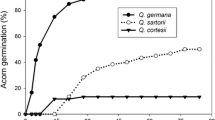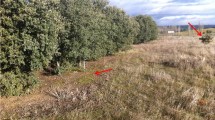Abstract
Partial consumption of acorns by rodents, birds, and insects has been widely reported in various oak species. However, to what extent these partially eaten acorns contribute to the regeneration of oak trees is poorly understood. To date, there is limited knowledge of the effects of seed availability on partial consumption of acorns. Herein, we released tagged Quercus mongolica acorns in two consecutive years with different seed crops, to explore the probability of partial acorn consumption. We also placed simulated partially consumed acorns in the field to investigate their contribution to regeneration of white oak. Our results showed that more acorns were partially eaten in a good crop year than in poor crop year, reflecting an effect of predator satiation on acorn partial consumption by rodents at the population level. Partially eaten acorns were more likely to be damaged at the basal end, suggesting consistent consumption preferences of small rodents. Although, partially consumed acorns were less likely to be scatter-hoarded by small rodents, they germinated more rapidly than the intact acorns in the field, offsetting the negative effects of the non-buried deposition. Despite lower germination rates, lightly damaged acorns exhibited greater growth of roots and shoots, suggesting a compensatory response to partial acorn consumption. Partial consumption may spread predation pressure on acorns and thus appears to be much better for the plant than total consumption by seed-eating animals. Therefore, partially consumed acorns as dispersal leftovers may play a potential role in natural regeneration of Quercus mongolica, especially in mast years. However, this role and the underlying mechanisms of partial acorn consumption by rodents, birds, and herbivore insects need further investigation.





Similar content being viewed by others
References
Andersson C, Frost I (1996) Growth of Quercus robur seedlings after experimental grazing and cotyledon removal. Acta Bot Neerl 45:85–94
Bonal R, Muñoz A, Díaz M (2007) Satiation of predispersal seed predators: the importance of considering both plant and seed level. Evol Ecol 21:367–380
Bonfil C (1998) The effects of seed size, cotyledon reserves and herbivory on seedling survival and growth in Quercus rugosa and Q. laurina (Fagaceae). Am J Bot 85:79–87
Borchert MI, Davis FW, Michaelsen J, Oyler LD (1989) Interaction of factors affecting seedling recruitment of blue oak (Quercus douglasii) in California. Ecology 70:389–404
Bossema L (1979) Jays and oaks: An eco-ethological study of a symbiosis. Behaviour 70:1–117
Branco M, Branco C, Merouani H, Almeida MH (2002) Germination success, survival and seedling vigour of Quercus suber acorns in relation to insect damage. Forest Ecol Manage 166:159–164
Crawley MJ, Long CR (1995) Alternate bearing, predator satiation and seedling recruitment in Quercus robur L. J Ecol 83:683–696
Den Ouden J, Jansen PA, Smit R (2005) Jays, mice and oaks: predation and dispersal of Quercus robur and Q. petraea in North-western Europe. In: Forget PM, Lambert J, Hulme P, Vander Wall SB (eds) Seed fate. CABI Publishing, Cambridge, pp 223–240
Dube S, Mlambo D, Sebata A (2010) Response of Faidherbia albida (Del.) A. Chev., Acacia nigrescens Oliver. and Acacia nilotica (L.) Willd ex Del. seedlings to simulated cotyledon and shoot herbivory in a semi-arid savanna in Zimbabwe. African J Ecol 48:361–367
Dunning CE, Paine TD, Redak RA (2002) Insect-oak interactions with coast live oak (Quercus agrifolia) and Engelmann oak (Q. engelmannii) at the acorn and seedling stage. In: Standiford RB, McCreary D, Purcell KL (eds) Proceedings of the fifth symposium on oak woodlands: oaks in California’s challenging landscape. Gen. Tech. Rep. PSW-GTR-184, Pacific Southwest Research Station, Forest Service, U.S. Department of Agriculture, Albany, pp 205–218
Fineblum WL, Rausher MD (1995) Trade-off between resistance and tolerance to herbivore damage in a morning glory. Nature 377:517–520
Frost I, Rydin H (1997) Effects of competition, grazing and cotyledon nutrient supply on growth of Quercus robur seedlings. Oikos 79:53–58
Fukumoto H, Kajimura H (2000) Effects of insect predation on hypocotyl survival and germination success of mature Quercus variabilis acorns. J Forest Res 5:31–34
Hou XG, Yi XF, Yang YQ, Liu WJ (2010) Acorn germination and seedling survival of Q. variabilis: effects of cotyledon excision. Ann Forest Sci 67:711
Janzen DH (1971) Seed predation by animals. Ann Rev Ecol Syst 2:465–492
Kelly D (1994) The evolutionary ecology of mast seeding. Trends Ecol Evol 9:465–470
Kelly D, Sork VL (2002) Mast seeding in perennial plants: why, how, where? Trends Ecol Evol 33:427–447
Kikuzawa K, Koyama H (1999) Scaling of soil water absorption by seeds: an experiment using seed analogues. Seed Sci Res 9:171–178
Lambert JE (2002) Exploring the link between animal frugivory and plant strategies: the case of primate fruit-processing and post-dispersal seed fate. In: Levey DJ, Silva WR, Galetti M (eds) Seed dispersal and frugivory: ecology, evolution and conservation. CAB International, Wallingford, pp 365–379
Maetô K (1995) Relationship between size and mortality of Quercus mongolica var. grosseserrate acorns due to pre-dispersal infestation by frugivorous insects. J Japan Forest Soc 77:213–219
Mellanby K (1968) The effect of some mammals and birds on the regeneration of oaks. J Appl Ecol 5:359–366
Milberg P, Lamont BB (1997) Seed/cotyledon size and nutrient content play a major role in early performance of species on nutrient-poor soils. New Phytol 137:665–672
Miyaki M, Kikuzawa K (1988) Dispersal of Quercus mongolica acorns in a broadleaved deciduous forest 2. Scatterhoarding by mice. Forest Ecol Manage 25:9–16
Moore JE, Swihart RK (2006) Diet choice of captive blue jays: implication for tree dispersal. Condor 108:377–388
Oak S (1993) Insects and diseases affecting oak regeneration success. In: Loftis D, McGee C (eds) Proceedings of oak regeneration symposium: serious problems-practical recommendations. Southeastern Forest Experimental Station, Asheville, pp 105–111
Ollerton J, Lack A (1996) Partial predispersal seed predation in Lotus corniculatus L. (Fabaceae). Seed Sci Res 6:65–69
Orians CM, Thorn A, Gómez S (2011) Herbivore-induced resource sequestration in plants: why bother? Oecologia 167(1):1–9. doi:10.1007/s00442-011-1968-2
Perea R, San Miguel A, Gil L (2011a) Leftovers in seed dispersal: ecological implications of partial seed consumption for oak regeneration. J Ecol 99:194–201
Perea R, San Miguel A, Martínez-Jauregui M, Valbuena-Carabaña M, Gil L (2011b) Effects of seed quality and seed location on the removal of acorns and beechnuts. Eur J Forest Res. doi:10.1007/s10342-011-0536-y
Pérez HE, Shiels AB, Zaleski HM, Drake DR (2008) Germination after simulated rat damage in seeds of two endemic Hawaiian palm species. J Trop Ecol 24:555–558
Servello FA, Kirkpatrick RL (1987) Regional variation in the nutritional ecology of ruffed grouse. J Wildl Manage 51:749–770
Shaw MW (1968) Factors affecting the natural regeneration of sessile oak (Quercus petraea) in North Wales: I. A preliminary study of acorn production, viability and losses. J Ecol 56:565–583
Short HL (1976) Composition and squirrel use of acorns of black and white oak groups. J Wildl Manage 40:479–483
Siemens DH, Lischke H, Maggiulli H, Schürchl S, Roy BA (2003) Cost of resistance and tolerance under competition: the defense-stress benefit hypothesis. Evol Ecol 17:247–263
Steele MA, Koprowski J (2001) North American tree squirrels. Smithsonian Institution Press, Washington
Steele MA, Knowles T, Bridle K, Simms EL (1993) Tannins and partial consumption of acorns: implications for dispersal of oaks by seed predators. Am Midl Nat 130:229–238
Steele MA, Hadj-Chikh L, Hazeltine J (1996) Caching and feeding decisions by Sciurus carolinensis: responses to weevil-infested acorns. J Mammal 77:305–314
Steele MA, Gavel K, Bachman W (1998) Dispersal of half-eaten acorns by gray squirrels: effects of physical and chemical seed characteristics. In: Steele MA, Merritt JF, Zegers DA (eds) Ecology and evolutionary biology of tree squirrels. Virginia Museum of Natural History, Martinsville, pp 223–232
Vallejo-Marín M, Domínguez CA, Dirzo R (2006) Simulated seed predation reveals a variety of germination responses of neotropical rain forest species. Am J Bot 93:369–376
Vander Wall SB (1990) Food hoarding in animals. University of Chicago Press, Chicago
Westoby M, Jurado E, Leishman M (1992) Comparative evolutionary ecology of seed size. Tree 7:368–372
Xiao ZS, Harris MK, Zhang ZB (2007) Acorn defenses to herbivory from insects: implications for the joint evolution of resistance, tolerance and escape. Forest Ecol Manage 238:302–308
Yang YQ, Yi XF, Yu F (2011) Repeated radicle pruning of Quercus mongolica acorns as a cache management tactic of Siberian chipmunks. Acta Ethol. doi:10.1007/s10211-011-0102-0
Yi XF, Yang YQ (2010a) Large acorns benefit seedling recruitment by satiating weevil larvae in Quercus aliena. Plant Ecol 209:291–300
Yi XF, Yang YQ (2010b) Apical thickening of epicarp is responsible for embryo protection in acorns of Quercus variabilis. Israel J Ecol Evol 56:153–164
Yi XF, Zhang ZB (2008) Influence of insect-infested cotyledons on early seedling growth of Mongolian oak, Quercus mongolica. Photosynthetica 46:139–142
Zhang JH, Maun MA (1991) Effects of partial removal of seed reserves on some aspects of seedling ecology of seven dune species. Can J Bot 69:1457–1462
Acknowledgments
This study was financially supported by the Natural Science Foundation of China (No. 31172101), the National Basic Research Program of China (No. 2007CB109102), and the Program for Science and Technology Innovation Talents in Universities of Henan Province (No. 2008 HASTIT003).
Author information
Authors and Affiliations
Corresponding author
Rights and permissions
About this article
Cite this article
Yang, Y., Yi, X. Partial acorn consumption by small rodents: implication for regeneration of white oak, Quercus mongolica . Plant Ecol 213, 197–205 (2012). https://doi.org/10.1007/s11258-011-0016-y
Received:
Accepted:
Published:
Issue Date:
DOI: https://doi.org/10.1007/s11258-011-0016-y




